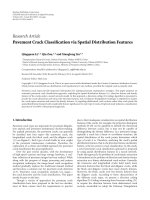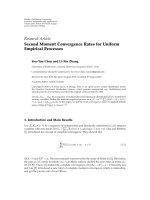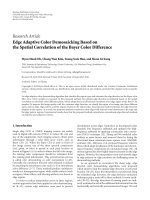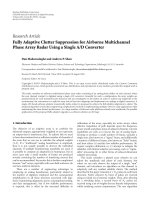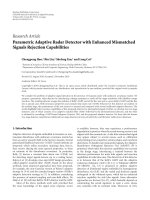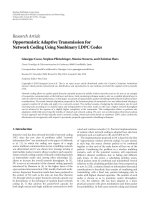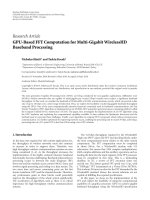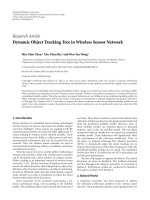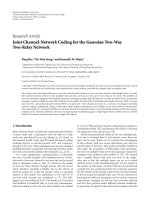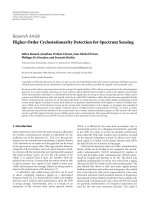Báo cáo hóa học: " Research Article Locally Adaptive DCT Filtering for Signal-Dependent Noise Removal" ppt
Bạn đang xem bản rút gọn của tài liệu. Xem và tải ngay bản đầy đủ của tài liệu tại đây (3.62 MB, 10 trang )
Hindawi Publishing Corporation
EURASIP Journal on Advances in Signal Processing
Volume 2007, Article ID 42472, 10 pages
doi:10.1155/2007/42472
Research Article
Locally Adaptive DCT Filtering for Signal-Dependent
Noise Removal
Rus¸en
¨
Oktem,
1
Karen Egiazarian,
2
Vladimir V. Lukin,
3
Nikolay N. Ponomarenko,
3
and Oleg V. Tsymbal
4
1
Electrical and Electronics Enginee ring Depar tment, Atılım University, Kızılcas¸ar K
¨
oy
¨
u, 06836
˙
Incek, Ankara, Turkey
2
Institute of Signal Processing, Tampere University of Technolog y, 33101 Tampere, Finland
3
Department of Receivers, Transmitters and Signal Processing, National Aerospace University, 17 Chkalova Street,
61070 Kharkov, Ukraine
4
Kalmykov Center for Radiophysical Sensing of Earth, 12 Ak. Proskury Street, 61085 Kharkov, Ukraine
Received 13 October 2006; Revised 21 March 2007; Accepted 13 May 2007
Recommended by Stephen Marshall
This work addresses the problem of signal-dependent noise removal in images. An adaptive nonlinear filtering approach in the
orthogonal transform domain is proposed and analyzed for several typical noise environments in the DCT domain. Being applied
locally, that is, within a window of small support, DCT is expected to approximate the Karhunen-Loeve decorrelating transform,
which enables effective suppression of noise components. The detail preservation ability of the filter allowing not to destroy any
useful content in images is especially emphasized and considered. A local adaptive DCT filtering for the two cases, when signal-
dependent noise can be and cannot be mapped into additive uncorrelated noise with homomorphic transform, is formulated.
Although the main issue is signal-dependent and pure multiplicative noise, the proposed filtering approach is also found to be
competing with the state-of-the-art methods on pure additive noise corrupted images.
Copyright © 2007 Rus¸en
¨
Oktem et al. This is an open access article distributed under the Creative Commons Attribution License,
which permits unrestricted use, distr ibution, and reproduction in any medium, provided the original work is properly cited.
1. INTRODUCTION
Digital images are often degr aded by noise, due to the im-
perfection of the acquisition system or the conditions dur-
ing the acquisition. Noise decreases the perceptual quality
by masking significant information, and also degrades per-
formance of any processing applied over the acquired image.
Hence, image prefiltering is a common operation used in or-
der to improve analysis and interpretation of remote sensing,
broadcast transmission, optical scanning, and other vision
data [1, 2].
Till now a great number of different image filtering tech-
niques have been designed including nonlinear nonadaptive
and adaptive filters [3, 4], transform-based methods [5–11],
techniques based on independent component analysis (ICA),
and principal component analysis (PCA) [12, 13], and so
forth.Thesetechniqueshavedifferent advantages and draw-
backs thoroughly discussed in [3, 4, 14], and other refer-
ences. The application areas and conditions for which the
use of these filters can be the most beneficial and expedient
depend on the filter properties, noise statistical characteris-
tics, and the priority of requirements. For effective filtering,
it is desirable to considerably suppress noise in homogeneous
(smooth) regions and to preserve edges, details, and texture
at the same time. Acceptable computational cost is the most
important requirement that can restrict a practical applica-
bility of some denoising techniques, for example, those based
onICAandPCA[12–14].
From the viewpoint of noise suppression, preservation of
edges, details and texture, and time efficiency requirements,
quite good effectiveness has been demonstrated by locally
adaptive methods [15–17]. The latest modifications of lo-
cally adaptive filters [16, 17] include both typical nonlin-
ear scanning window filters (employing order statistics) and
transform-based filters, in particular, filters based on discrete
cosine transform (DCT).
For many image denoising applications, it is commonly
assumed that the dominant noise is additive and its proba-
bility density function (pdf ) is Gaussian [3, 4, 18]. For mi-
crowave radar imagery, however, multiplicative noise is typ-
ical. The pdf of the noise can be either considered Gaus-
sian or non-Gaussian (e.g., Rayleigh, negative exponential,
gamma) depending on the radar type and its characteris-
tics [15, 16, 19]. Images scanned from photographic or some
2 EURASIP Journal on Advances in Signal Processing
medical images are other examples [6] where additive Gaus-
sian noise model fails.
Homomorphic transformation can sometimes be a rea-
sonable way of converting signal-dependent or pure multi-
plicative noise to an additive noise, which then can be filtered
appropriately [4, 16, 20–22]. However, quite often achiev-
able benefits are not so obvious [21, 22] and without losing
efficiency, it is possible to perform filtering without apply-
ing a homomorphic transformation to data (e.g., film-grain
noise). Lee or Kuan filters [23, 24] are among those conven-
tional and widely used techniques that aim to suppress mul-
tiplicative noise without the use of the homomorphic trans-
form. The performance of such filters is improved by their
integration into an iterative approach [25, 26]. However, iter-
ative techniques are usually computationally costly, and the y
often may introduce oversmoothing.
In this work, we aim to develop a class of transform-
based adaptive filters capable of suppressing signal-
dependent and multiplicative noise, while preserving
texture, edges, and details, which contain significant infor-
mation for further processing and interpreting of images. In
Section 2, we briefly overview a nonlinear transform domain
filtering (how it is derived from a least mean square sense
optimal filtering), for additive Gaussian noise. Note that
any decorrelating or thogonal transform will be a possible
choice for a transform domain filtering approach. Yet, we
concentrate on the DCT in the following sections, discussing
why we expect it to be a good choice for the transform
domain filtering. In Section 3, we propose our local adaptive
DCT (LADCT) filter in the presence of signal-dependent
and multiplicative noise. For signal-dependent and mul-
tiplicative noise, we treat two cases separately: where the
homomorphic transform can be and cannot be applied.
2. A BRIEF OVERVIEW OF TRANSFORM DOMAIN
FILTERS FOR ADDITIVE GAUSSIAN NOISE
A general observation model for noise (we deal within this
paper) can be expressed as
g
ij
= f
ij
+ f
γ
ij
· n
ij
,(1)
where g
ij
, f
ij
,andn
ij
denote the noisy image sample (pixel)
value, true image value, and signal-independent noise com-
ponent that is characterized by the variance σ
2
n
,respectively,
for the ijth sample. This model is a quite universal one, cov-
ering pure additive, signal-dependent, and pure multiplica-
tive noise cases. Let
f = H · g (2)
denote a linear filtering operation, where
f and g refer to the
vector of estimated signal and the observed (noisy) signal,
respectively, and H refers to the matrix of linear filter coeffi-
cients.
Consider the case where γ
= 0, corresponding to corrup-
tion with additive zero mean Gaussian noise (which is a valid
assumption for many practical applications [3, 4, 18]). The
coefficients of the linear optimal filter in the minimum mean
square error sense for this case is the one which minimizes
the mean square error between
f and f, and will be denoted
as
H
= R
ff
R
ff
+ σ
2
n
I
−1
. (3)
In (3), R
ff
is the correlation matrix of original data vector,
f.LetU and Δ be the matrices with eigenvectors and eigen-
values of R
ff
, respectively, that is, R
ff
= UΔU
T
. Then the
filtering matrix (3)becomes
H
= U
I + σ
2
n
Δ
−1
U
T
= U
ΔU
T
,(4)
where
Δ = diag{λ
1
/(λ
1
+σ
2
n
), λ
2
/(λ
2
+σ
2
n
), , λ
M
/(λ
M
+σ
2
n
)},
λ
i
being the eigenvalues of R
ff
.Equation(4) can be inter-
preted as mapping the signal into the Karhunen-Loeve trans-
form (KLT) domain, processing each coefficient individu-
ally, and then mapping the processed coefficients back to the
time/space domain.
Recall that in practical signal processing applications, due
to the need for a priori knowledge of the original signal statis-
tics, KLT is often replaced by a decorrelating transform with
fixed basis functions such as discrete cosine transform (DCT)
[27] or discrete wavelet transform (DWT) [8–11, 28, 29]. En-
ergy compaction and decorrelation are two important prop-
erties of orthogonal transforms exploited in denoising appli-
cations [5], because energy of white Gaussian noise is uni-
formly diffused over all vectors of any orthogonal transform,
and it is desirable to find a basis, which has appropriately
good energy compaction property for a near-optimum de-
noising.
DWT methods are generally the extensions to the work
of Donoho and Johnstone [30], where U is replaced with
U
a
, representing DWT, and
Δ is approximated with Δ
a
=
diag{λ
a
1
, λ
a
2
, , λ
a
M
},where
λ
a
i
=
⎧
⎨
⎩
1,
U
T
a
g
i
> thr
0, else,
(5)
or
λ
a
i
=
⎧
⎨
⎩
sgn
U
T
a
g
i
·
U
T
a
g
i
− thr
,
U
T
a
g
i
> thr
0, else,
(6)
and (U
T
a
g)
i
corresponds to the ith sample of the vector U
T
a
g.
The expression in (5) is referred to as a hard thresholding
and the one in (6) is a soft thresholding, thr denoting a pre-
set threshold. Donoho and Johnstone have proven that both
schemes are within the logarithmic factor of the mean square
error, and proposed thr
= k · σ
n
,wherek = 2
√
ln M (M de-
noting the length of the signal).
In DCT-based denoising, block-based processing is of-
ten preferred [27], since this not only enables fast and mem-
ory efficient implementations but also exploits local quasis-
tationarybehaviorofimages.DCTapproximatesKLTfor
highly correlated data in a windowed region of natural im-
ages [31]. Two other clear advantages of DCT are that, being
Rus¸en
¨
Oktem et al. 3
involved in standard compression schemes [32], fast imple-
mentation structures have been widely developed and DCT-
based implementations can easily be embedded in those
standard schemes.
3. DCT FILTERING FOR MULTIPLICATIVE AND
SIGNAL-DEPENDENT NOISE CASES
As it was mentioned earlier, multiplicative noise is typical for
radar and ultrasound imaging systems [15, 19, 20]. The noise
characteristics in radar images depend upon several factors
such as a system type—whether one deals with an image ob-
tained by synthetic aperture radar (SAR) or side look aper-
ture radar (SLAR) [15, 19]. Additionally, multiplicative noise
(speckle) characteristics are determined by a radar operation
mode, for example, is a SAR image one look or multilook.
The simplified radar image models commonly take the mul-
tiplicative noise into account only, and can be described by
(1), when γ
= 1[19]. Then, (1) can be updated as follows:
g
ij
= f
ij
+ f
ij
· n
ij
= f
ij
μ
ij
,(7)
where the multiplicative noise factor can also be expressed as
μ
ij
= 1+n
ij
. According to (1), the variance σ
2
μ
of the variable
μ is similar to σ
2
n
for γ = 1. Note that σ
2
μ
is often referred to
as multiplicative noise or speckle (relative) variance.
In SLAR image case, μ is Gaussian with its mean value
equal to unity. For the simplified model (7)ofapuremul-
tiplicative noise, the influence of a radar point spread func-
tion and an additive noise is often neg lected. In most of the
real cases σ
2
μ
is considered to be a constant value for the en-
tire image. Typical values of σ
2
μ
are commonly of the order
0.004
···0.02 for SLAR images and slightly larger for multi-
look SAR images [15, 33].
In SAR images, σ
2
μ
is determined by a method of forming
a one-look SAR image and a number of looks N
looks
used.
Statistical experiments carried out using the standard χ
2
test
show that if a one-look SAR image is formed as an estimate
of the backscattered signal amplitude, then it is enough to
have N
looks
> 8···9 in order to consider multiplicative noise
Gaussian in obtained multilook SAR image. Similarly, if a
one-look SAR image is formed as an estimate of the backscat-
tered signal intensity (and pdf of original speckle in one-look
SAR image is negative exponential), then N
looks
> 30 ···35 is
enough to accept hypothesis on Gaussian pdf of multiplica-
tive noise in multilook SAR image with a probability over
0.5. In other words, if in a multilook SAR image one has
σ
2
μ
< 0.035, an assumption on Gaussianity of multiplicative
noise is valid.
As it is demonstrated in [15], the model (7) is, in gen-
eral, applicable to describe radar images corrupted by non-
symmetric pdf speckle which is ty pical for images formed
by SAR with a small number of looks [19]. Note that often
the quality of original images and their filtered versions is ex-
pressed in terms of equivalent number of looks [19]. It is also
worth noting that if the corresponding prefiltering of images
with non-Gaussian speckle has been carried out, the resid-
ual noise in homogeneous regions, being still multiplicative,
approximately obeys Gaussian distribution [15, 33].
It directly follows from (1)and(7) that, in the homoge-
neous regions of SLAR and SAR images, local variance σ
2
g
of
fluctuations due to multiplicative noise (speckle) is strictly
connected with the local mean
g
loc
: σ
2
g
≈ σ
2
μ
g
2
loc
[15, 19].
This property is widely exploited in denoising of images cor-
rupted by multiplicative noise [23–26].
3.1. Local adaptive filtering for pure multiplicative
noise (γ
= 1)
In order for us to cope with the multiplicative noise, nonlin-
ear transform domain denoising described in Section 2 can
be combined with the homomorphic transformation [15, 22]
that converts the multiplicative noise into additive noise.
Note that the use of the homomorphic transformations is
a commonly recommended way for processing of data cor-
rupted by a multiplicative noise [4]. Its basic motivation is
that this leads to reduced complexity (simplification) of situ-
ation one has to deal with. This is true in some cases, but not
always.
In this case, we obtain a denoising scheme where the in-
put passes through the homomorphic transformation of the
logarithmic type at first, then a denoising operation is per-
formed, and finally, the obtained image is subject to the in-
verse homomorphic transformation. Such scheme can be de-
noted as Hom
→ H → Hom
−1
where Hom and Hom
−1
de-
note a pair of direct and inverse homomorphic transforms,
respectively, and H denotes the applied filter.
Note that after Hom, one can obtain additive noise with
probability density function close to Gaussian if and only if:
originally pure multiplicative noise has been Gaussian and
this noise has been characterized by a rather small relative
variance σ
2
μ
(the tests have shown that it should be smaller
than 0.02). In all other cases, the obtained additive noise does
not obey Gaussian dist ribution and this can cause problems
in transform-based denoising. For example, this happens for
images corrupted by nonsymmetric pdf speckle (Rayleigh,
negative exponential, gamma, etc.) that are typical for im-
ages formed by SARs with one or few looks [15, 20, 22]. Af-
ter direct homomorphic transform of logarithmic type such
speckle noise becomes additive but also nonsymmetric (with
respect to its mean) and heavy tailed. Removal of such noise
is not a typical and simple task. In other words, the situation
after transformation does not become simpler than it was be-
fore it.
In [16], it was proposed to convert a multiplicative noise
as expressed by (7) to an additive noise by means of the direct
homomorphic transform g
h
ij
= [a log
b
(g
ij
)], where a and b
areconstantsand[
·] denotes rounding-off to the nearest in-
teger. The recommended values of a and b for the t raditional
8-bit representation of gray-scale images were equal to 8.39
and 1.2, respectively. If σ
2
μ
≤ 0.02, for the images obtained
after aforementioned direct homomorphic transform, noise
could be considered G aussian, additive with zero mean and
variance equal to σ
2
additive
= a
2
· σ
2
μ
/(ln b)
2
.
On one hand, according to our investigations [16],
rounding-off to the nearest integer introduces some distor-
tions (additional errors) due to direct and, then, inverse
4 EURASIP Journal on Advances in Signal Processing
homomorphic transforms, that is, g
ij
can be only approxi-
mately equal to Hom
−1
(Hom(g
ij
)). In general, filtering can
be applied to data represented as floating point values. On
the other hand, the application of DCT and other transform-
based filters to integer-valued data commonly provides con-
siderably better computational efficiency than if these filters
are applied to real valued images [34].
Therefore, the image processing scheme Hom
→ H →
Hom
−1
has some restrictions in terms of its application
in practice. At the same time, in the case of pure multi-
plicative noise there is another possibility to perform a lo-
cal DCT-based filtering. For this purpose, we prefer to ap-
proximate the filtering operation of (4) in the DCT domain
by exploiting the thresholding operation in (5)-(6)withan
adaptive scheme. Note that when the denoised image pix-
els in each block are obtained directly through the inverse
DCT of the thresholded coefficients for that block as in [27],
pseudo-Gibbs phenomena, that is, undershoots and over-
shoots, around the neighborhood of discontinuities occur
[28]. In order to overcome this, we propose to generate mul-
tiple denoised estimates instead of a single one, for each pixel
in the block at first. Then, the filtered intensity value for a
particular pixel can be obtained through averaging (weighted
averaging) over those multiple estimates. Neighboring and
overlapping blocks can provide multiple estimates, when the
block window is sliding in the vertical and horizontal direc-
tions. Averaging over multiple estimates suppresses under-
shoots and overshoots, in a way analogous to the transla-
tion invariant denoising proposed by Coifman and Donoho
in [28]. The main idea is to decrease the effect of misalign-
ment between the signal and the basis function, by shifting
the signal a number of times.
This algorithm of DCT-based denoising can be, in gen-
eral, summarized below.
(1) Divide an image to be processed into overlapping
blocks (scanning windows) of size M
× M;lets be a
shift (in one dimension, row, or columnwise) in pixels
between two neighboring overlapping blocks.
(2) For each block, with the left upper corner in the ijth
pixel, assign
x( m, l)
= g(i + m, j + l), m, l = 0, , M − 1. (8)
(i) Calculate the DCT coefficients as follows:
X[p, q]
=c[p]c[q]
M−1
m=0
M
−1
l=0
x( m, l)
× cos
(2m +1)pπ
2M
cos
(2l +1)qπ
2M
,
(9)
where
c[p]
=
⎧
⎪
⎪
⎪
⎨
⎪
⎪
⎪
⎩
2
M
,1
≤ p ≤ M − 1,
1
√
M
, p
= 0,
c[q]
=
⎧
⎪
⎪
⎪
⎨
⎪
⎪
⎪
⎩
2
M
,1
≤ q ≤ M −1,
1
√
M
, q
= 0.
(10)
(ii) Apply thresholding to the DCT coefficients
X[p, q] according to the selected type of thresh-
olding (either hard (5)orsoft(6)) and obtain
X
th
[p, q].
(iii) Obtain the estimates within each block by ap-
plying the inverse D CT to the thresholded trans-
form c oefficients as
x
f
(m, l) =c[p]c[q]
M−1
p=0
M
−1
q=0
X
th
[p, q]
× cos
(2m +1)pπ
2M
cos
(2l +1)qπ
2M
.
(11)
(iv) Get the filtered values for the block as
f (i + m, j + l) = x
f
(m, l), m, l = 0, , M − 1. (12)
(3) O btain the final estimate
f
f
ij
for a pixel at ijth loca-
tion by averaging the multiple estimates of it, these
come from neighboring overlapping blocks including
that pixel.
If the homomorphic transform is not applied, there is the fol-
lowing distinction. For the thresholding step, (2)(ii), we pro-
pose to adjust the threshold value for each image block sepa-
rately (individually). Specifically, a rough supposition can be
made that a noise within a small image block is close to ad-
ditive. In this case, the noise variance within the block can be
calculated as σ
2
g
≈ g
2
· σ
2
μ
where (g) is the local mean of the
pixels in this block. Thus, the threshold value for each block
should be chosen as k
·σ
μ
·g where k is a constant (more thor-
ough background is given in the next subsection). We refer
to this algorithm for denoising of multiplicative noise as local
adaptive DCT denoising with s number of overlaps (LADCT -
s). The same algorithm when fixed threshold is used is re-
ferred to as LDCT throughout the paper.
If one uses a scheme Hom
→ H → Hom
−1
where H
is the DCT-based filtering algorithm described above, Hom
should be applied to the whole image before step 1, with ob-
taining g
h
ij
= [a log
b
(g
ij
)] and applying all steps 1–3 to g
h
.
As the result, after executing step 3, one obtains
f
f
h
and then
for an entire image, the inverse homomorphic transform will
be performed to obtain the filtered image
f
f
. In that case, a
threshold value used at the step (2)(ii) will be fixed for all
blocks used, thr
= k · σ
additive
with σ
additive
= a · σ
μ
/(ln b).
Similarly, one has to set thr
= k ·σ
n
if a noise is pure additive
(γ
= 0 in the model (1)).
Although we study a multiplicative noise model in this
work, we compared the per formance of the above proposed
algorithm in presence of additive Gaussian noise with that of
the state-of-the-art wavelet denoising methods [8, 9, 11, 29].
Our simulations showed that the proposed algorithm com-
petes with GSMWD, which is reportedly one of the best de-
noising methods in the literature. Gaussian scale mixtures
Rus¸en
¨
Oktem et al. 5
Table 1: PSNR results of processing the test image including texture regions, corrupted by multiplicative noise, σ
2
μ
= 0.012.
Denoising techniques Thresholding type and threshold value Local PSNR, dB
Original image — 23.62
Haar wavelet Soft: 1.2σ
n
26.39
Haar wavelet Hard: 2.8σ
n
27.63
Symmlet wavelet Soft: 1.2σ
n
27.37
Symmlet wavelet Hard: 2.6σ
n
27.96
Extended symmlet wavelet Soft, auto-adjusting of threshold 28.26
LDCT-1 Hard: 2.6σ
n
28.76
LADCT-1 Hard with adaptation: k = 2.6 28.91
in the wavelet domain (GSMWD) [29] is a wavelet denois-
ing technique based on a local Gaussian scale mixture model
in an overcomplete oriented pyramid representation. The
performance of DCT-based denoising for additive Gaussian
noise can be increased w ith weighted processing of estimates
obtained from different overlapping blocks like in [35, 36]
or by the use several transforms in a switch [36], of nonequal
shape and size of blocks (.fi/
∼foi/SA-DCT),
and so forth.
3.2. Experimental results with pure
multiplicative noise (γ
= 1)
Let us now analyze and compare the performance of the
scheme Hom
→ H → Hom
−1
, the proposed LADCT-s, and
some other filters. First, we consider a particular task of tex-
ture preservation. In [16], we have thoroughly discussed tex-
ture preserving properties of a wide set of different filters.
It has been demonstrated that the procedure Hom
→ H →
Hom
−1
where H was DCT-based filtering for additive noise
outperformed such good detail preserving filters like stan-
dard and modified sigma filters [33], local statistic Lee [23],
FIR median hybrid and center weighted median filters [3],
and so forth. However, the comparison to wavelet-based de-
noising methods has not been carried out.
The studies in [16] have been accomplished for the cases
of prevailing Gaussian multiplicative noise with relative vari-
ance values σ
2
μ
= 0.005 and σ
2
μ
= 0.012 typical for SLAR
images. These values satisfy aforementioned condition σ
2
μ
≤
0.02. Below we consider a particular case of σ
2
μ
= 0.012.
Taking into account the fact that wavelet-based denois-
ing is commonly applied to images corr upted by additive
noise, let us perform a performance comparison between
wavelet and DCT-based denoising methods under an as-
sumption of transform-based filter to be used within the
scheme Hom
→ H → Hom
−1
, that is, in fact, for additive
noise. For this purpose, let us consider the same test image
as that one used in [16] (see Figure 1). Among the wavelet
denoising techniques the following have been examined: the
Haar wavelet, the Daubechies, and Symmlet wavelets, all with
hard (HT) and soft (ST) thresholding. The obtained data
are presented in Table 1 . Note that DCT-based filtering with
hard thresholding (thr
= 2.6σ
n
)ands = 1hasbeenused.
We have also tested the proposed LADCT-s (the last row
Figure 1: The noise-free test image with four texture regions (two
of rectangular and two of circular shape).
in Table 1 ) directly on noisy image (without homomorphic
transforms). The listed threshold values in Table 1 are the
ones for which corresponding wavelet denoising techniques
provide the best local PSNR for texture regions and near best
PSNR for the entire image. Local PSNR has been computed
as PSNR
loc
= 10 · log(255
2
/MSE
loc
) where MSE
loc
has b een
calculated for all pixels belonging to all four texture regions
in the test image (see Figure 1). All wavelet denosing tech-
niques have been implemented by the software tool obtained
from WaveLab for MATLAB (www-stat.Stanford.edu).
As seen, for textural regions both DCT-based filtering
techniques produce the best (largest) local PSNRs. They
are by 0.5
···2.5 dB better than for the considered wavelet
denosing schemes. The scheme Hom
→ LDCT-1 → Hom
−1
and LADCT-1 produce practically equal PSNR
loc
although
for the latter technique PSNR
loc
is slightly larger. Since
LADCT-1 does not require performing homomorphic trans-
formations and the only additional operations are calcula-
tion of local means in all blocks and their multiplying by
kσ
μ
(both are very simple), practical application of LADCT-
1 seems preferable in comparison to Hom
→ LDCT-1 →
Hom
−1
.
This conclusion has also been confirmed by simulation
data presented in our earlier paper [22]. It is shown there for
the test image “Montage” corrupted by pure multiplicative
noise with σ
2
μ
= 0.035 that PSNR values for LADCT-1 are
6 EURASIP Journal on Advances in Signal Processing
(a)
(b)
Figure 2: Original SLAR image (a) and the output image after ap-
plying LADCT-1 (b).
Table 2: PSNR results for Boat, degraded with multiplicative noise,
γ
= 1.
σ
μ
Kuan
1
[25] Kuan
3
[25] LADCT-1
0.1 29.72 30.88 32.24
0.2
25.74 26.81 28.88
0.3
22.85 23.65 26.84
about 0.6 dB better than for the scheme Hom → LDCT-1 →
Hom
−1
.
An example of applying LADCT-1 with hard threshold-
ing (k
= 2.6) to a real SLAR image with σ
2
μ
= 0.012 is pre-
sented in Figure 2(a). Noise is well seen, especially in image
regions with rather large local mean. The obtained output
image is shown in Figure 2(b). Noise is considerably sup-
pressed in image homogeneous regions while useful infor-
mation like edges, fine details, and texture is preserved well.
Table 3: SNR results for Lenna, degraded with 16-looks speckle
noise.
Noisy image K uan FMP [37] LADCT-1
7.8 dB 16.1 19.1 dB 19.8 dB
We also have compared our method LADCT-1 (hard
thresholding, k
= 2.6) with the one of the most recent and
competitive method called fuzzy matching pursuit (FMP)
[37]. Recursive Kuan filters [25] and conventional Kuan fil-
ters [24] have been also considered. The results are pre-
sented in Tables 2, 3. They show the superiority of local adap-
tive DCT filtering (LADCT) for removing pure multiplica-
tive noise. LADCT-1 outperforms Kuan filter-based iterative
technique by approximately 2 dB (see data in Tab le 2)and
the FMP based technique by 0.7 dB (see data in Table 3).
Note that advantages of LADCT (larger PSNR or SNR values)
become especially obvious for more intensive multiplicative
noise (large values of σ
μ
).
One more example of using LADCT-1 with hard thresh-
olding (k
= 2.6) is g iven in Figure 3. An original image
was formed by a two-look SLAR image where each look im-
age represent a spatial estimate of reflected signal amplitude.
Thus, σ
2
μ
is about 0.14. As expected, speckle is well seen visu-
ally and it is rather intensive. The output image is demon-
strated in Figure 3(b). Fine details and edges are perfectly
retained while in image homogeneous regions noise is sup-
pressed well.
Above we prefer to use SNR or PSNR as the quantita-
tive measures of filtering performance. Sometimes, equiva-
lent number of looks is employed to characterize and com-
pare the performance of different filters. But this criterion ba-
sically relates to noise suppression in image homogeneous re-
gions while integral and local PSNR values are able to quanti-
tatively describe filter effectiveness for entire images and their
fragments, respectively.
3.3. Local adaptive filtering for film-grain
noise (0 <γ<1)
Thetypeofnoisedescribedby(1)when0<γ<1 is generally
referred as film-grain noise, and occurs when photographic
films are scanned, due to the granularity of photo-sensitive
crystals on the film [24, 26]. It is a special case where it is
not possible to reform (1) into (7) by homomorphic trans-
forms. Most of the existing methods for removing such type
of noise rely on recursive filtering [25, 26]. In [6], an approx-
imation of mean square error filtering in the transform do-
main is formulated, and a wavelet domain denoising method
is proposed as a faster and edge preserving filtering alter-
native to recursive type of filters. Here, we revisit the mean
square error filtering approach, and propose a DCT domain
filter, which exploits local stationary characteristics of natu-
ral images.
Rus¸en
¨
Oktem et al. 7
(a)
(b)
Figure 3: Original SAR image (a) and t he output image after apply-
ing LADCT-1 (b).
Let us get back to the filtering operation expressed by (2),
where the noisy image is expressed as in (1). Then the opti-
mum filter H
γ
, in the least mean square error sense will be
H
γ
= R
ff
R
ff
+ σ
2
n
R
γ
−1
, (13)
where R
γ
stands for the autocorrelation matrix f
γ
=
[ f
γ
1
, f
γ
2
, , f
γ
M
]
T
, f
i
representing the original data samples.
Equation (13) can be reformulated as
H
γ
= U
I + σ
2
n
U
T
R
γ
UΔ
−1
−1
U
T
= U
I + σ
2
n
R
γ
Δ
−1
−1
U
T
,
(14)
where R
ff
= UΔU
T
and
R
γ
= U
T
R
γ
U. Consider the case of
slowly varying data, such as f
i
varies in close vicinity of its
mean
f . That is, the data vector can be expressed as
f
=
f + δ
1
, f + δ
2
, , f + δ
M
T
, (15)
where δ
i
are zero mean iid random variables with variance
σ
2
δ
. When σ
2
δ
is small enough, then, the γth root of f
i
can be
approximated as f
γ
= [ f
γ
+ δ
1
, f
γ
+ δ
2
, , f
γ
+ δ
M
]
T
,where
δ
i
are zero mean iid random variables with variance σ
2
δ
≤ σ
2
δ
.
In that case, the autocorrelation matrices R
ff
and R
γ
can be
expressed as R
ff
= f
2
· P + σ
2
δ
· I, R
γ
= f
2γ
· P + σ
2
δ
· I
Table 4: SNR results for Lenna, degraded with film-grain type of
noise at 2.9 dB.
γ LLMMSE M-LLMMSE AWD [6] LADCT-8 LADCT-1
0.2 12.0 14.7 14.3 14.3 16.1
0.4 12.1 14.8 14.9 15.2 16.8
0.6 12.3 15.0 14.9 15.3 17.1
where P refers to the matrix of ones. Then, the matrix which
diagonalizes R
ff
also diagonalizes R
γ
,and(14) reduces to the
same form as (4),
H
γ
= U
Δ
γ
U
T
, (16)
where
Δ = diag{λ
1
/(λ
1
+ σ
2
n
· f
2γ
), λ
2
/(λ
2
+ σ
2
n
· f
2γ
), ,
λ
M
/(λ
M
+ σ
2
n
· f
2γ
)}, when σ
2
δ
, σ
2
δ
terms are ignored. Our
simulations show that the above statements related to R
ff
and R
γ
areaccurateaslongas(15)holdsfor3·σ
δ
< f ,which
is a safe assumption within a small support of image data.
Hence, the proposed algorithm in Section 3.1 canbeusedas
an approximation to the filtering expressed by (16), when
thr
= k · σ
n
· f
γ
. (17)
f denotes an approximation to the true data at the corre-
sponding pixel, and we use the DC coefficient of the corre-
sponding DCT block for it. Since the DC coefficient corre-
sponds to sum of the pixel values in that block, scaled by c[0]
(see (9)), we further multiply it by c[0] to obtain the sample
mean of the block.
It follows from (17) that for a pure multiplicative noise
(γ
= 1) the threshold in each block is to be set as k · σ
μ
· g,
that is, our earlier intuitive assumption has been confirmed.
3.4. Experimental results with film-grain
noise (0 <γ<1)
We tested our formulation on Lenna, Barbara, and Boat im-
ages, for which either PSNR or SNR results with recent fil-
tering techniques are available in the literature. Although k
is recommended to be 2
√
ln M (= 2.9forM = 8 × 8 win-
dow size) in [30], we performed and reported our simula-
tions for k
= 2.6 (which achieved better performance in our
simulations), and used soft thresholding. The corrupted im-
ages are generated by using the film-grain noise model with
γ
={0.2, 0.4, 0.6}. We have compared our results with AWD
[6] and multiscale local linear minimum mean square error
filter (LLMMSE) [38]—an improvement of the Kuan filter.
AWD is a wavelet denoising technique developed for data-
dependent noise removal, which uses adaptive thresholding.
The threshold is calculated by using previously filtered low
resolution subband samples in a wavelet decomposition hi-
erarchy.
The results for LADCT-1 are considerably better than
those for LADCT-8 (compare data in two rightmost
columns in Tables 4–6). LADCT-1 p erforms 1.4 dB to 2.1 dB
better than multiscale LLMMSE filter for Lenna image
(see Ta ble 4). The results of multiscale LLMMSE filter do
8 EURASIP Journal on Advances in Signal Processing
Table 5: SNR results for Boat, degraded with film-grain type of noise at 2.9 dB SNR.
γ LLMMSE AWD [6] LADCT-8 LADCT-1
Overall Detail Overall Detail Overall Detail Overall Detail
0.2 10.27 7.44 10.72 7.36 11.05 7.71 12.94 10.30
0.4
10.31 7.57 10.81 7.61 11.08 7.33 12.98 10.45
0.6
10.46 7.84 10.86 7.85 11.69 8.05 13.12 10.31
(a) (b) (c)
(d) (e) (f)
Figure 4: Portion of the Boat image: (a) original, (b) film-grain noised at 2.9 dB (γ = 0.4), (c) LLMMSE filtered, (d) adaptive wavelet
denoised, (e) LADCT-8, (f) LADCT-1 filtered.
Table 6: SNR results for Barbara, degraded with film-grain type of
noise at 2.9 dB SNR.
γ LLMMSE AWD [6] LADCT-8 LADCT-1
0.2 9.66 9.89 10.49 12.60
0.4 9.67 9.83 10.46 12.90
0.6 9.67 9.78 10.51 12.62
not exist for Boat and Barbara test images in the litera-
ture. Compared to LLMMSE filter, LADCT-1 outperforms it
by ∼4.5 dB, ∼2.6 dB, ∼3dBforLenna,Boat,andBarbara,
respectively. Even when there is no overlapping of blocks
(denoted as LADCT-8), LADCT slightly outperforms M-
LLMMSE, and outperforms LLMMSE by from 0.8 to 3.1 dB.
The SNR values obtained for LADCT-1 are also considerably
better than for the AWD filter [6]. Note that in Table 5 we
give not only SNR values calculated for entire (overall) test
image, but also the values of local SNR determined for het-
erogeneous (detail) regions of the test image Boat. Both over-
all and local SNRs for LADCT-1 are considerably better com-
pared to the corresponding data for LLMMSE and AWD (see
Tab le 5).
Subjective evaluations also favor LADCT. Figure 4 dis-
plays portions of the original, noisy (at 2.9 dB, γ
= 0.4), and
filtered Boat images. Figures 4(e)-4(f) present more pleas-
ant display than the other two methods (wavelet denoising
with adaptive thresholding [6]inFigure 4(d), and LLMMSE
in Figure 4(c)). Figure 4(c) shows that LLMMSE especially
fails in removing noise at and around the edges. It shows that
LADCT-1 not only suppresses noise, but also preserves the
details better than the competing techniques.
Rus¸en
¨
Oktem et al. 9
4. CONCLUSIONS
This work considers and introduces a class of transform do-
main filters for enhancing signal-dependent and multiplica-
tive noise corrupted images. We address the case both when
multiplicative noise can be and cannot be turned into addi-
tive noise with homomorphic transform. We show that op-
timal linear filtering in the least mean square error sense for
both cases can be approximated by an adaptive threshold-
ing scheme in the orthogonal transform domain, and dis-
cuss that block-based DCT is a preferable choice as the trans-
form. We exploit the local sliding window (block) approach,
which improves the performance by decreasing overshoot-
ing and undershooting artifacts of thresholding. The test re-
sults prove that our local adaptive DCT (LADCT) filters not
only outperform existing filters attacking signal-dependent
and multiplicative noise, but also compete with the state-of-
the-art additive Gaussian noise filtering techniques. It is also
illustrated by Figures and Tables that LADCT filters preserve
details and texture better while removing noise at those re-
gions.
REFERENCES
[1] R. M. Haralick and L. G. Shapiro, Computer and Robot V ision,
Addison-Wesley, Reading, Mass, USA, 1992.
[2] N. Pierdicca, R. Crapolicchio, P. Basili, P. Ciotti, G. d’Auria,
and F. S. Marzano, “Classification of multifrequency radar
polarimetric data: role and contribution of vectorial filters,”
in Proceedings of International Geoscience and Remote Sensing
Symposium (IGARSS ’95), vol. 3, pp. 1915–1917, Firenze, Italy,
July 1995.
[3] J. Astola and P. Kuosmanen, Fundamentals of Nonlinear Digital
Filtering, CRC Press LLC, Boca Raton, Fla, USA, 1997.
[4] I. Pitas and A. N. Venetsanopoulos, Nonlinear Digital Filters:
Principles and Applications, Kluwer Academic Publishers, Dor-
drecht, The Netherlands, 1990.
[5] G. Strang and T. Nguyen, Wavelets and Filter Banks,Wellesley
Cambridge Press, Wellesley, Mass, USA, 1996.
[6] R.
¨
Oktem and K. Egiazarian, “Transform domain algorithm
for reducing effect of film-grain noise in image compression,”
Electronics Le tters, vol. 35, no. 21, pp. 1830–1831, 1999.
[7] D. L. Donoho, “De-noising by soft-thresholding,” IEEE Trans-
actions on Information Theory, vol. 41, no. 3, pp. 613–627,
1995.
[8] A. A. Bharath and J. Ng, “A steerable complex wavelet con-
struction and its application to image denoising,” IEEE Trans-
actions on Image Processing, vol. 14, no. 7, pp. 948–959, 2005.
[9] M. S. Crouse, R. D. Nowak, and R. G. Baraniuk, “Wavelet-
based statistical signal processing using hidden Markov mod-
els,” IEEE Transactions on Signal Processing,vol.46,no.4,pp.
886–902, 1998.
[10] L. S¸endur and I. W. Selesnick, “Bivariate shrinkage functions
for wavelet-based denoising exploiting interscale dependency,”
IEEE Transactions on Signal Processing, vol. 50, no. 11, pp.
2744–2756, 2002.
[11] P L. Shui, “Image denoising algorithm via doubly local
Wiener filtering with directional windows in wavelet do-
main,” IEEE Signal Processing Letters, vol. 12, no. 10, pp.
681–684, 2005.
[12] A. Hyvarinen, P. Hoyer, and E. Oja, “Image denoising by sparse
code shrinkage,” in Intelligent Signal Processing,S.Haykinand
B. Kosko, Eds., pp. 554–568, IEEE Press, New York, NY, USA,
2001.
[13] D. D. Muresan and T. W. Parks, “Adaptive principal compo-
nents and image denoising,” in Proceedings of IEEE Interna-
tional Conference on Image Processing (ICIP ’03), vol. 1, pp.
101–104, Barcelona, Spain, September 2003.
[14] M. C. Motwani, M. C. Gadiya, R. C. Motwani, and F. C. Har-
ris, “Survey of image denoising techniques,” in Proceedings of
Global Signal Processing Expo and Conference (GSPx ’04),Santa
Clara, Calif, USA, September 2004.
[15] V. Melnik, “Nonlinear locally adaptive techniques for im-
age filtering and restoration in mixed noise environments,”
Thesis for the degree of Doctor of Technology, Tam-
pere University of Technology, Tampere, Finland, 2000,
/>∼roktem/Research/interests.htm.
[16] O. V. Tsymbal, V. V. Lukin, N. N. Ponomarenko, A. A. Ze-
lensky, K. Egiazarian, and J. T. Astola, “Three-state locally
adaptive texture preserving filter for radar and optical im-
age processing,” EURASIP Journal on Applied Signal Processing,
vol. 2005, no. 8, pp. 1185–1204, 2005.
[17] N. N. Ponomarenko, V. V. Lukin, A. A. Zelensky, K. Egiazar-
ian, and J. T. Astola, “Locally adaptive image filtering based on
learning with clustering,” in Image Processing: Algorithms and
Systems IV, vol. 5672 of Proceedings of SPIE, pp. 94–105, San
Jose, Calif, USA, January 2005.
[18] V. P. Melnik, V. V. Lukin, A. A. Zelensky, J. T. Astola, and P. Ku-
osmanen, “Local activity indicators for hard-switching adap-
tive filtering of images with mixed noise,” Optical Engineering,
vol. 40, no. 8, pp. 1441–1455, 2001.
[19] C. Oliver and S. Quegan, Understanding Synthetic Aperture
Radar Images, SciTech, Raleigh, NC, USA, 2004.
[20] S. Solbo and T. Eltoft, “Homomorphic wavelet-based statis-
tical despeckling of SAR images,” IEEE Transactions on Geo-
science and Remote Sensing, vol. 42, no. 4, pp. 711–721, 2004.
[21] V. V. Lukin, V. P. Melnik, V. I. Chemerovsky, S. Peltonen, and
P. Kuosmanen, “Use of homomorphic transforms in locally
adaptive filtering of radar images,” in Nonlinear Image Process-
ing XI, vol. 3961 of Proceedings of SPIE, pp. 184–195, San Jose,
Calif, USA, January 2000.
[22] K. O. Egiazarian, V. P. Melnik, V. V. Lukin, and J. T. Astola, “Lo-
cal transform-based denoising for radar image processing,” in
Nonlinear Image Processing and Pattern Analysis XII, vol. 4304
of Proceedings of SPIE, pp. 170–178, San Jose, Calif, USA, Jan-
uary 2001.
[23] J. S. Lee, “Refined filtering of noise using local statistics,” Com-
puter Graphics and Image Processing, no. 24, pp. 259–269, 1983.
[24] D. T. Kuan, A. A. Sawchuk, T. C. Strand, and P. Chavel, “Adap-
tive noise smoothing filter for images with signal-dependent
noise,” IEEE Transactions on Pattern Analysis and Machine In-
telligence, vol. 7, no. 2, pp. 165–177, 1985.
[25] L. Klaine, B. Vozel, and K. Chehdi, “An integro-differential
method for adaptive filtering of additive or multiplicative
noise,” in Proceedings of IEEE International Conference on
Acoustics, Speech and Signal Processing (ICASSP ’05), vol. 2, pp.
1001–1004, Philadelphia, Pa, USA, March 2005.
[26] S. I. Sadhar and A. N. Rajagopalan, “Image estimation in film-
grain noise,” IEEE Signal Processing Letters, vol. 12, no. 3, pp.
238–241, 2005.
[27] L. Yaroslavsky and M. Eden, Fundamentals of Digital Optics,
Birkhauser, Boston, Mass, USA, 1996.
10 EURASIP Journal on Advances in Signal Processing
[28] R. Coifman and D. L. Donoho, “Translation-invariant de-
noising,” in Wavelets and Statistics, A. Antoniadis, Ed., vol. 103
of Lecture Notes in Statistics, pp. 125–150, Springer, New York,
NY, USA, 1995.
[29] J. Portilla, V. Strela, M. J. Wainwright, and E. P. Simon-
celli, “Image denoising using scale mixtures of Gaussians in
the wavelet domain,” IEEE Transactions on Image Processing,
vol. 12, no. 11, pp. 1338–1351, 2003.
[30] D. L. Donoho and J. M. Johnstone, “Ideal spatial adaptation
by wavelet shrinkage,” Biometrika, vol. 81, no. 3, pp. 425–455,
1994.
[31] A. N. Akansu and R. A. Haddad, Multiresolution Signal De-
composition: Transforms, Subbands, Wavelets, Academic Press,
San Diego, Calif, USA, 2nd edition, 2001.
[32] N. N. Ponomarenko, V. V. Lukin, K. Egiazarian, and J. Astola,
“DCT based high quality image compression,” in Proceedings
of the 14th Scandinavian Conference on Image Analysis (SCIA
’05), vol. 3540 of Lecture Notes in Computer Science, pp. 1177–
1185, Joensuu, Finland, June 2005.
[33] V. V. Lukin, N. N. Ponomarenko, L. Yu. Alekseyev, V. P. Mel-
nik, and J. T. Astola, “Two-stage radar image despeckling based
on local statistic Lee and sigma filter ing,” in Nonlinear Image
Processing and Pattern Analysis XII, vol. 4304 of Proceedings o f
SPIE, pp. 106–117, San Jose, Calif, USA, Januar y 2001.
[34] H. Huang, X. Lin, S. Rahardja, and R. Yu, “A method for
realizing reversible integer type-IV discrete cosine transform
(IntDCT-IV),” in Proceedings of the 7th International Confer-
ence on Signal Processing (ICSP ’04), vol. 1, pp. 101–104, Bei-
jing, China, August-September 2004.
[35] O. G. Guleryuz, “Weighted overcomplete denoising,” in Pro-
ceedings of the 37th Conference Record of the Asilomar Confer-
ence on Signals, Systems and Computers, vol. 2, pp. 1992–1996,
Pacific Grove, Calif, USA, November 2003.
[36] K. Egiazarian, J. Astola, M. Helsingius, and P. Kuosmanen,
“Adaptive denoising and lossy compression of images in trans-
form domain,” Journal of Electronic Imaging,vol.8,no.3,pp.
233–245, 1999.
[37] B. Aiazzi, S. Baronti, and L. Alparone, “Blind image estima-
tion through fuzzy matching pursuits,” in Proceedings of IEEE
International Conference on Image Processing (ICIP ’01), vol. 1,
pp. 241–244, Thessaloniki, Greece, October 2001.
[38] F. Argenti, G. Torricelli, and L. Alparone, “Signal-dependent
noise removal in the undecimated wavelet domain,” in Pro-
ceedings of IEEE International Conference on Acoustics, Speech
and Signal Processing (ICASSP ’02), vol. 4, pp. 3293–3296, Or-
lando, Fla, USA, May 2002.
Rus¸en
¨
Oktem was born in Turkey, in 1973.
She received her B.S. degree in electr ical and
electronics engineering from Bilkent Uni-
versity, Turkey, in 1994, her M.S. and Ph.D.
degrees in signal and image processing from
Tampere University of Technology, Finland,
in 1997 and 2000, respectively. She is work-
ing as an Assistant Professor at Electrical
and Electronics Engineering Department of
Atılım University, Ankara, Turkey, where
she is teaching and leading or supporting state and EU projects.
Her research topics include image enhancement, image compres-
sion, feature extraction, and stochastic processing of RF signals.
Karen Egiazarian was born in Yerevan, Ar-
menia, in 1959. He received the M.S. degree
in mathematics from Yerevan State Univer-
sity in 1981, the Ph.D. degree in physics and
mathematics from Moscow State University,
Moscow, Russia, in 1986, and the D.Tech.
degree from Tampere University of Tech-
nology (TUT), Tampere, Finland, in 1994.
He was a Senior Researcher with the De-
partment of Digital Signal Processing, In-
stitute of Information Problems and Automation, and National
Academy of Sciences of Armenia. Since 1996, he has been an As-
sistant Professor with the Institute of Signal Processing, Tampere
University of Technology, where he is currently a Professor, leading
the Transforms and Spectral Methods Group. His research inter-
ests are in the areas of applied mathematics, signal processing, and
digital logic.
Vladimir V. Lukin graduated from Kharkov
Aviation Institute (now National Aerospace
University, Kharkov, Ukraine) and got
diploma with honor in radioengineering.
Since then, he has been with the Depart-
ment of Transmitters, Receivers and Signal
Processing of the same University. He re-
ceived Candidate of Technical Science de-
gree in 1988 and Doctor of Technical Sci-
ence degree in 2002 and became Professor
in 2003. He has published more than 250 journal and conference
papers, more than 100 are in English. His research interests include
remote sensing data processing, adaptive filtering of signals and im-
ages.
Nikolay N. Ponomarenko is a Senior Re-
searcher of Department of Transmitters, Re-
ceivers and Signal Processing of National
Aerospace University of Ukraine. He got
a diploma in computer sciences from Na-
tional Aerospace University of Ukraine in
1993, Candidate of Technical Sciences de-
gree (in remote sensing area) from the
Highest Attestation Commission of Ukraine
in 2004, and Doctor of Technology degree
(in image compression area) from Tampere University of Technol-
ogy, Finland, in 2005. His research interests are image and video
compression, denoising, and quality assessment.
Oleg V. Tsymbal graduated from National
Aerospace University, Kharkov, Ukraine in
1998 and got diploma with honor in com-
puter sciences. In 2003, he defended Candi-
date of Technical Science t hesis in Ukraine,
and in 2005, he got Doctor of Technology
degree from Tampere University of Tech-
nology, Finland. Currently, he is w ith Visy
Oy, Finland. His research interests include
remote sensing data processing and adap-
tive image denoising.
